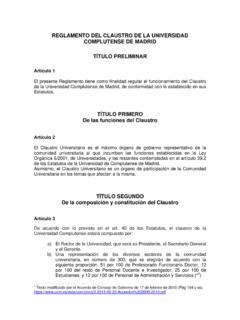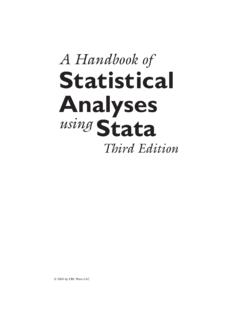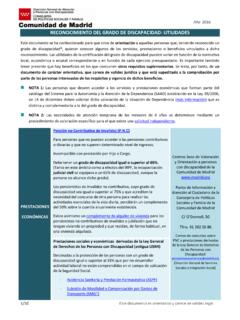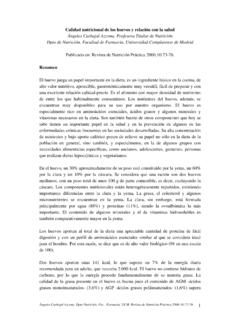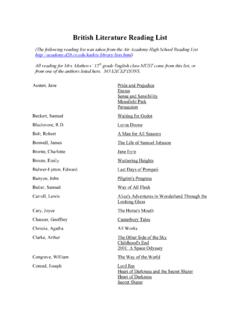Transcription of The Development of English Literature (Summary) Old ...
1 1 The Development of English Literature (Summary) Old English , Middle English and Chaucer Old English English , as we know it, descends from the language spoken by the north Germanic tribes who settled in England from the 5th century onwards. They had no writing (except runes, used as charms) until they learned the Latin alphabet from Roman missionaries. The earliest written works in Old English (as their language is now known to scholars) were probably composed orally at first, and may have been passed on from speaker to speaker before being written.
2 We know the names of some of the later writers (C dmon, lfric and King Alfred) but most writing is anonymous. Old English Literature is mostly chronicle and poetry - lyric, descriptive but chiefly narrative or epic. Middle English and Chaucer From 1066 onwards, the language is known to scholars as Middle English . Ideas and themes from French and Celtic Literature appear in English writing at about this time, but the first great name in English Literature is that of Geoffrey Chaucer (?1343-1400).
3 Chaucer introduces the iambic pentameter line, the rhyming couplet and other rhymes used in Italian poetry (a language in which rhyming is arguably much easier than in English , thanks to the frequency of terminal vowels). Some of Chaucer's work is prose and some is lyric poetry, but his greatest work is mostly narrative poetry, which we find in Troilus and Criseyde and The canterbury Tales. other notable mediaeval works are the anonymous Pearl and Gawain and the Green Knight (probably by the same author) and William Langlands' Piers Plowman.
4 Tudor lyric poetry Modern lyric poetry in English begins in the early 16th century with the work of Sir Thomas Wyatt (1503-1542) and Henry Howard, Earl of Surrey (1517-1547). Wyatt, who is greatly influenced by the Italian, Francesco Petrarca (Petrarch) introduces the sonnet and a range of short lyrics to English , while Surrey (as he is known) develops unrhymed pentameters (or blank verse) thus inventing the verse form which will be of great use to contemporary dramatists.
5 A flowering of lyric poetry in the reign of Elizabeth comes with such writers as Sir Philip Sidney (1554-1586), Edmund Spenser (1552-1599), Sir Walter Raleigh (1552-1618), Christopher Marlowe (1564-1593) and William Shakespeare (1564-1616). The major works of the time are Spenser's Faerie Queene, Sidney's Astrophil and Stella and Shakespeare's sonnets. Renaissance drama The first great English dramatist is Marlowe. Before the 16th century English drama meant the amateur performances of Bible stories by craft guilds on public holidays.
6 Marlowe's plays (Tamburlaine; Dr. Faustus; Edward II and The Jew of Malta) use the five act structure and the medium of blank verse, which Shakespeare finds so productive. Shakespeare develops and virtually exhausts this form, his Jacobean successors producing work which is rarely performed today, though some pieces have literary merit, notably The Duchess of Malfi and The White Devil by John Webster (1580-1625) and The Revenger's Tragedy by Cyril Tourneur (1575-1626). The excessive and gratuitous violence of Jacobean plays leads to the clamour for closing down the theatres, which is enacted by parliament after the Civil war.
7 Metaphysical poetry The greatest of Elizabethan lyric poets is John Donne (1572-1631), whose short love poems are characterized by wit and irony, as he seeks to wrest meaning from experience. The preoccupation with the big questions of love, death and religious faith marks out Donne and his successors who are often called metaphysical poets. (This name, coined by Dr. Samuel Johnson in an essay of 1779, was revived and popularized by Eliot, in an essay of 1921. It can be unhelpful to modern students who are unfamiliar with this adjective, and who are led to think that these poets belonged to some kind of school or group - which is not the case.)
8 After his wife's death, Donne underwent a serious religious conversion, and wrote much fine devotional verse. The best known of the other metaphysicals are George Herbert (1593-1633), Andrew Marvell (1621-1678) and Henry Vaughan (1621-1695). Epic poetry Long narrative poems on heroic subjects mark the best work of classical Greek (Homer's Iliad and Odyssey) and Roman (Virgil's neid) poetry. John Milton (1608-1674) who was Cromwell's secretary, set out to write a great biblical epic, unsure whether to write in Latin or English , but settling for the latter in Paradise Lost.
9 John Dryden (1631-1700) also wrote epic poetry, on classical and biblical subjects. Though Dryden's work is little read today it leads to a comic parody of the epic form, or mock-heroic. The best poetry of the mid 18th century is the comic 2 writing of Alexander Pope (1688-1744). Pope is the best-regarded comic writer and satirist of English poetry. Among his many masterpieces, one of the more accessible is The Rape of the Lock (seekers of sensation should note that rape here has its archaic sense of removal by force ; the lock is a curl of the heroine's hair).
10 Serious poetry of the period is well represented by the neo-classical Thomas Gray (1716-1771) whose Elegy Written in a Country Churchyard virtually perfects the elegant style favoured at the time. Restoration comedy On the death of Oliver Cromwell (in 1658) plays were no longer prohibited. A new kind of comic drama, dealing with issues of sexual politics among the wealthy and the bourgeois, arose. This is Restoration Comedy, and the style developed well beyond the restoration period into the mid 18th century almost.



